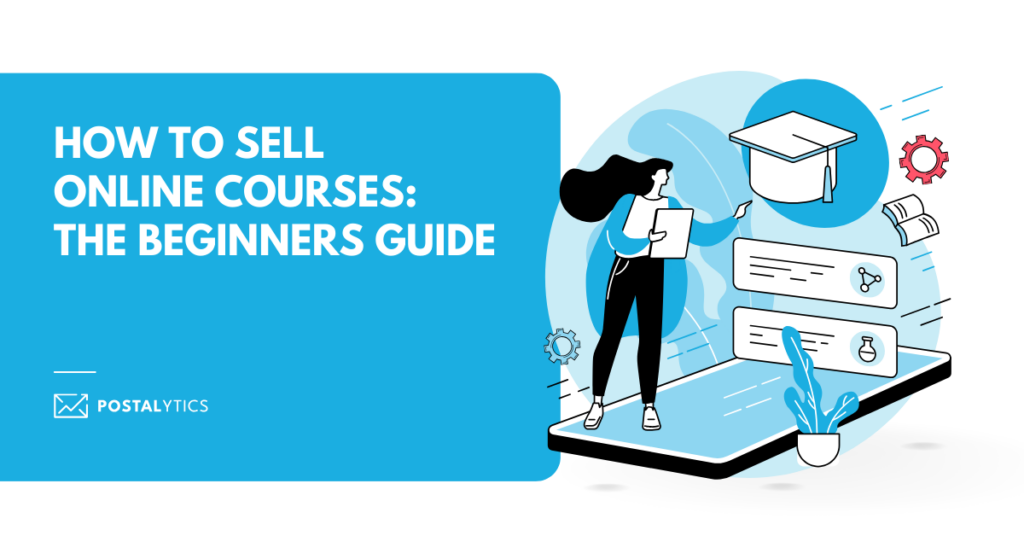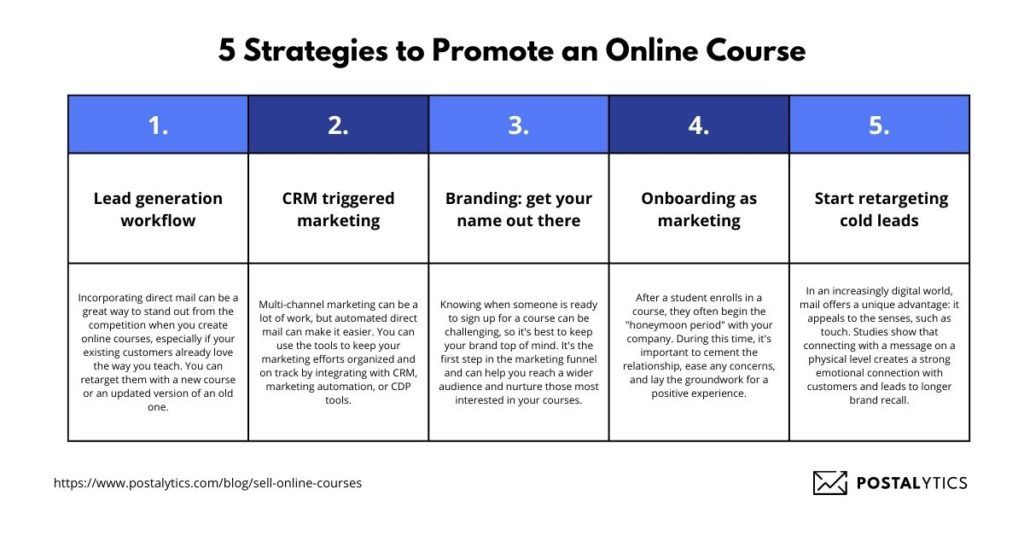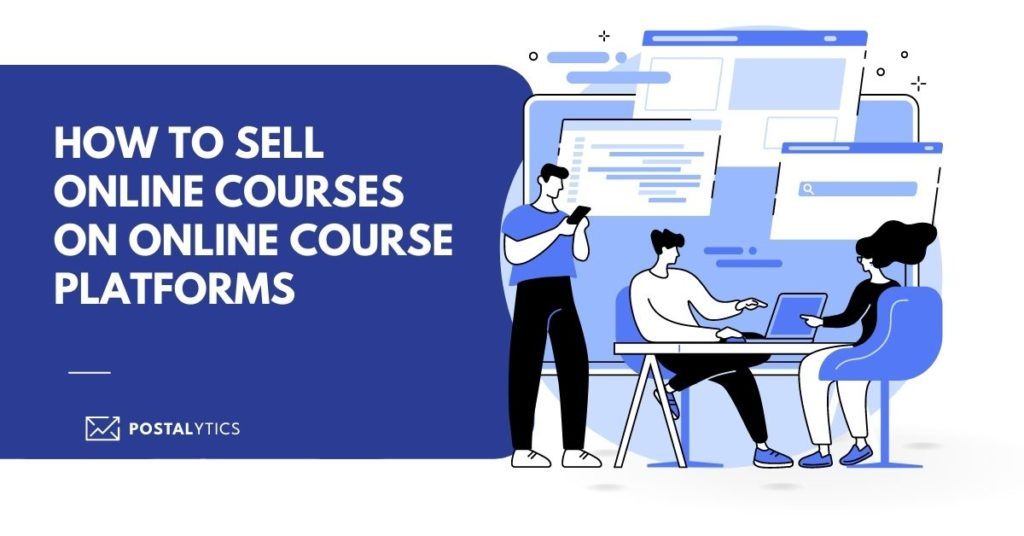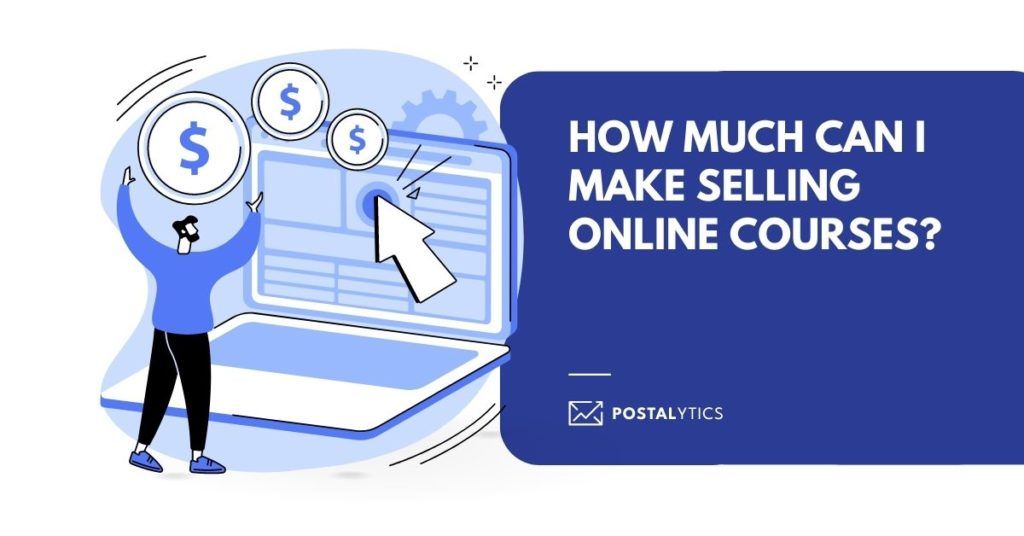
With the rising popularity of online education, there is an excellent opportunity for companies and individuals to grow their businesses by selling online courses.
More companies are also using online business courses to train their employees, replacing traditional classroom training. The opportunities presented by selling online courses have spread across both B2C and B2B markets, creating a $148 billion market today.
If you are looking for a way to generate leads that will significantly increase your sales while reducing challenges, automated marketing will help you seamlessly share the most important information with potential students.
With Postalytics, you can create powerful triggered direct mail campaigns to generate new leads, activate old ones, and reach new customers. You also can create professionally designed postcards and letters using templates and easy-to-use design tools.
Postalytics is an excellent choice for educational marketers selling e-courses who want to achieve their goals. To learn more, check out the demo from Postalytics.
Let’s explore how to sell online courses with automated marketing tools this year.
What we’ll cover:
- How do you sell an online course?
- 1. Start Getting Leads: Lead Gen Workflow
- 2. CRM triggered marketing campaigns
- 3. Branding: get your name out there
- 4. Onboarding new students as a marketing strategy
- 5. Start retargeting cold leads
- How to sell online courses on social media
- How to sell online courses on online course platforms
- Can you sell online courses for free?
- The benefits of selling an online course
- Is selling online courses profitable?
- What are some of the best-selling online courses?
- The online courses that are in high demand
- How much can you make selling online courses?
- Final thoughts
How do you sell an online course?
To be a successful online instructor and sell courses online, you need more than a great course. You also need a process to attract and enroll students in your online learning program. This process is called a sales funnel. And it takes your future students all the way from discovery to onboarding into your digital classroom.
If you are looking for ideas on how to plan your next direct mail campaign, check out these five strategies to help you build a successful online course.

1. Start Getting Leads: Lead Gen Workflow
Incorporating direct mail can be a great way to stand out from the competition when you create online courses, especially if your existing customers already love the way you teach. You can retarget them with a new course or an updated version of an old one.
To start marketing to potential students when you launch your own online course, you first need to find leads. You can use multiple channels to reach out to potential customers and draw them into your first online course. This is called multi-channel lead generation. By using various channels, you can cast a wider net and boost your chances of connecting with a potential student interested in your online course.
Here’s how it works:
- You find potential prospects using available data, based on your course’s target customer profile. Then, send emails to introduce the course.
- Then, send out a direct mail piece or a letter package highlighting the course and presenting a special offer or additional free courses.
- You continue targeting and retargeting through further promotion with email and direct mail marketing.
We have seen this approach work well for our customers – 72% of Postalytics customers have seen higher response rates when automated direct mail is added to the email and other digital marketing campaigns.
2. CRM triggered marketing campaigns
Multi-channel marketing can be a lot of work, but automated direct mail can make it easier. You can use the tools to keep your marketing efforts organized and on track by integrating with CRM, marketing automation, or CDP tools. Thanks to Postalytics, building an automated sales engine with triggered mail has never been easier or more cost-effective. Our tools can fully and seamlessly integrate with the rest of your tech stack.
Instead of relying on traditional marketing methods, connect your automation tool with Postalytics. This way, you can use your data to drive your marketing strategy. Triggered drip campaigns are a great way to stay in touch with your customers all year round and ensure you send postcards and letters to nurture them throughout your sales process.
Most Americans feel like life-long students nowadays, so they’re eager to jump on to the next educational opportunity.
This Postalytics client successfully used a triggered marketing strategy to market their continuing education services, accelerating lead generation and growing their business.
3. Branding: get your name out there
Knowing when someone is ready to sign up for a course can be challenging, so it’s best to keep your brand top of mind. It’s the first step in the marketing funnel and can help you reach a wider audience and nurture those most interested in your courses.
By communicating regularly through email and direct mail, you’ll stay top of mind and increase the likelihood of potential clients reaching out to you when they are ready to study. These marketing benefits will compound down the line. Once you become known for your courses, they’ll fly off your virtual shelves just because they’re coming from you. However, in the case of branding, you’re reaping what you saw years earlier by staying top of mind and constantly communicating with your potential students.
An automated direct mail workflow that starts with a postcard nurtures your leads via email and ends with a direct mail offer or invitation can help you accomplish this and deliver a consistent message across multiple channels.
E-learning is constantly evolving, and the most successful companies are those that stay ahead of the curve. As a marketer of online courses, it is crucial to have access to campaign analytics to inform your marketing strategy. We have developed a user-friendly and easy-to-understand dashboard where you can access the analytics sourced from your email and direct mail performance 24/7.
4. Onboarding new students as a marketing strategy
After a student enrolls in a course, they often begin the “honeymoon period” with your company.
During this time, it’s important to cement the relationship, ease any concerns, and lay the groundwork for a positive experience. It’s an opportunity to send an automated direct mail campaign that makes the customer feel welcome, appreciated, and informed. They will appreciate this and may also share it with others in their network. Your onboarding marketing outreach can include an email teaser with direct mail, such as an email alerting them to a welcome gift from you, followed by a direct mail piece with thank you and introductory information.
5. Start retargeting cold leads
In an increasingly digital world, mail offers a unique advantage: it appeals to the senses, such as touch.
Studies show that connecting with a message on a physical level creates a strong emotional connection with customers and leads to longer brand recall. In an age where we are constantly bombarded with advertising messages, taking the time to connect with customers on a physical level will make all the difference.
This may be precisely what your cold leads need to decide to sign up for your online course. For example, you could launch an automated direct mail campaign directed at cold leads with a letter to re-introduce the course and offer them a special deal to help turn the needle in your favor.
How to sell online courses on social media
Most social platforms offer clients a solution where they can create paid advertising campaigns and target specific audiences using demographic characteristics. This can be very useful for reaching a target audience for online courses to generate leads.
An effective marketing strategy would be to set up a course sales landing page you can use to collect pre-orders or signups for your email list before the course goes live. You can add a call to action to your social media ad that offers free content that will be useful to people when they sign up and drives them to this landing page.
Once you have someone’s email address, you have a lead you can target with more information about your online course. By integrating with HubSpot, Mailchimp, and other CRM tools, Postalytics makes it easy to set up automated drip campaigns tied to your online school to accomplish this.

How to sell online courses on online course platforms
Both an LMS (Learning Management System) and e-learning platforms can be used to help educators and learners organize, view, and manage the learning process of their online course platform. If you want to sell online courses, you may choose an LMS to host your online course and integrate it with the tools you need to market your business.
Postalytics integrates with LMS marketing channels like Mailchimp, HubSpot, Salesforce, and Zapier, so you can connect your direct mail campaigns directly to your CRM to integrate it with email and advertising campaigns when you are selling courses. This way, you can easily promote your course website, track the results of your campaigns and measure your return on investment (ROI).
Can you sell online courses for free?
Using self-hosted WordPress LMS plugins on your own website frees up course creators from the fees and restrictions of using hosted e-learning platforms for online course creation. Not only can you maximize your revenue using your own website, but you can also create and promote your courses yourself.
As an edupreneur or a marketer working with one, you are probably looking for ways to keep costs down and save time so you can focus on selling online courses. With your Postalytics account, you can easily create and manage a multi-channel marketing campaign linked to your LMS website.
With our free, customizable templates for postcards, letters, and other direct mail, you can get your campaign up and running quickly and easily – from idea to first scheduled delivery takes just 10 minutes.
Plus, we will print and mail your campaign for you, so you don’t have to worry about designers, printers, or postage. However, the entire process won’t be entirely free, but more on the low-cost side of things.
The benefits of selling an online course
The business of online courses has many advantages, one of the biggest being that there are no physical products to deal with. Your products don’t have a physical shelf-life as long as the information inside of them is easy to update. Also, each course is different and can not be copied exactly, which gives you an advantage over your competition.
Plus, the way you teach, structure your course material, create content, and add value is unique to you and your brand, which allows you to scale your business effectively. And then there’s the fact that you can run and market an online course business from your laptop – anywhere, anytime.
Is selling online courses profitable?
You can start your e-learning business and create an online course with very little initial investment. The most important investment you need to make is time. Financially, online courses also offer high-profit margins, making them profitable. With few costs – such as marketing and equipment costs (e.g., video lighting or a professional microphone for video hosting) – you can achieve a high return on investment.
Plus, you can charge a high premium for the right online course. If you provide value and results to your course participants, you can justify a high price, increase profit margins, and create a profitable online course. With an automated marketing tool like Postalytics, you can drastically reduce your marketing and postage costs to improve these profit margins.
What are some of the best-selling online courses?
According to CEO Magazine, the top three best-selling online courses marketed through search engines, membership sites, youtube videos, Facebook groups, or a social media presence fall into the following categories:
- Computers and Technology: IT-related courses such as programming, web design, and development with WordPress.
- Business and Management: e-learning on business strategies and entrepreneurship programs.
- Arts and Crafts: these online courses allow learners to earn money from their hobbies and entertain them simultaneously.
The online courses that are in high demand
With the rapidly changing realities of the business world and the rise of freelancers and startups, the need for e-learning on business strategies and entrepreneurship has skyrocketed.
Websites like Etsy and Amazon allow millions of people to sell their products online, an excellent opportunity for those with knowledge and skills in arts and crafts. With the right course, students can explore entrepreneurship and learn how to start their own business – which is why online arts and crafts courses are some of the most in-demand online courses.
Students can enjoy a unique advantage. They don’t need to have everything figured out in their teens. Most of today’s high-paying jobs don’t require fancy degrees but practical skills and knowledge. This is where e-learning comes in.

How much can you make selling online courses?
The million-dollar question, literally.
Online courses can be a profitable option if you want to earn extra money creating online courses or turning your passion into a full-time income. By becoming a course creator and marketing your own course, you can reach a broad audience of potential students interested in learning what you have to offer by directing them to your sales pages. Many online course authors earn $1,000 to $10,000 per month. According to Forbes, you can make six figures with the right marketing for your online course.
Final thoughts
Ready to create, market, and sell your online course?
Online courses are not a magic ticket to instant wealth. They’re an honest business and require a lot of hard work to get off the ground. To start selling, you must be willing to invest time and effort to successfully market to your target audience and highlight your unique selling point. If you are looking for a way to increase online course sales, Postalytics is a good place to start.
With Postalytics, you can build more personalized relationships with potential students and keep your brand top of mind. What’s more, Postalytics is a powerful marketing tool because it integrates with your existing digital marketing campaigns to create a true multi-channel approach for a more profitable online course business.
About the Author

Dennis Kelly
Dennis Kelly is CEO and co-founder of Postalytics. Dennis joined Boingnet, the predecessor to Postalytics, in 2013. Boingnet was focused on providing print and direct mail marketing service providers the ability to add digital marketing channels to their direct mail campaigns. Postalytics is Dennis’ 6th startup. He has been involved in starting and growing early-stage technology ventures for over 30 years and has held senior management roles at a diverse set of large technology firms including Computer Associates, Palm Inc. and Achieve Healthcare Information Systems.
